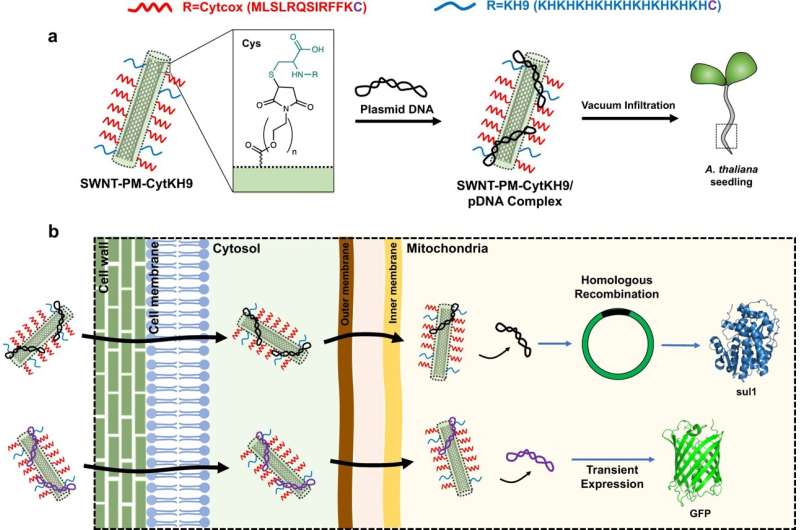Delivering genes into plant mitochondria using polymer-coated carbon nanotubes

RIKEN biologists have found an effective way to smuggle genetic material into the energy generators of plant cells, opening up the possibility of coaxing plants to produce commercially useful compounds. Their research appears in Nature Communications.
With the global population expected to reach nearly 10 billion people in 2050, the ability to tinker with the genetics of plants to boost the production of food will be vital to feed the world.
Plants are also anticipated to become biofactories for producing useful chemicals such as drugs and fuels. "They can be engineered to produce other stuff besides food, such as various chemicals, pharmaceuticals, and recombinant proteins," says Simon Law of the RIKEN Center for Sustainable Resource Science (CSRS). "The fact that you can use plants to make a lot of different things makes biotechnology such a promising field."
One way to "reprogram" plants is to import genetic material into their cells, but this is challenging due to the thick cell wall that blocks many biomolecules.
Carbon nanotubes—rolled-up tubes of graphene that are a mere nanometer or so in diameter—are sufficiently slim to slip through the cell wall. But once inside the plant cell, carbon nanotubes are not very effective at targeting mitochondria—a key organelle responsible for generating energy and making and breaking down various compounds.
"Getting stuff through the cell wall, the cell membrane and then past mitochondria membranes is difficult and it hadn't been achieved with high efficiency previously," notes Law.
Now, Law, Keiji Numata, also of CSRS, and co-workers have used carbon nanotubes to ship snippets of DNA into plant mitochondria at high efficiency. They achieved this by first coating the carbon nanotubes with a polymer layer that allowed for conjugation of short strings of amino acids known as peptides. The peptides enabled the carbon nanotubes to target mitochondria.
By conjugating the peptides on carbon nanotubes, the team enhanced the efficiency of DNA transfer to mitochondria by a remarkable 30 times compared with previous attempts that just used peptides.
"The first time I ran the experiment, I doubted the results as they seemed too high to be reasonable," recalls Law. "But I became more confident after repeating it a few times and obtaining similar results."
The researchers demonstrated the usefulness of their method by using it to import a gene that enhanced the growth rate of plants. Other potential uses include speeding up breeding programs and altering metabolic pathways so that they produce commercially useful chemicals. Furthermore, by varying the peptides coated on the nanotubes, it should be possible to target other organelles in plant cells.
More information: Simon Sau Yin Law et al, Polymer-coated carbon nanotube hybrids with functional peptides for gene delivery into plant mitochondria, Nature Communications (2022). DOI: 10.1038/s41467-022-30185-y
Journal information: Nature Communications
Provided by RIKEN





















